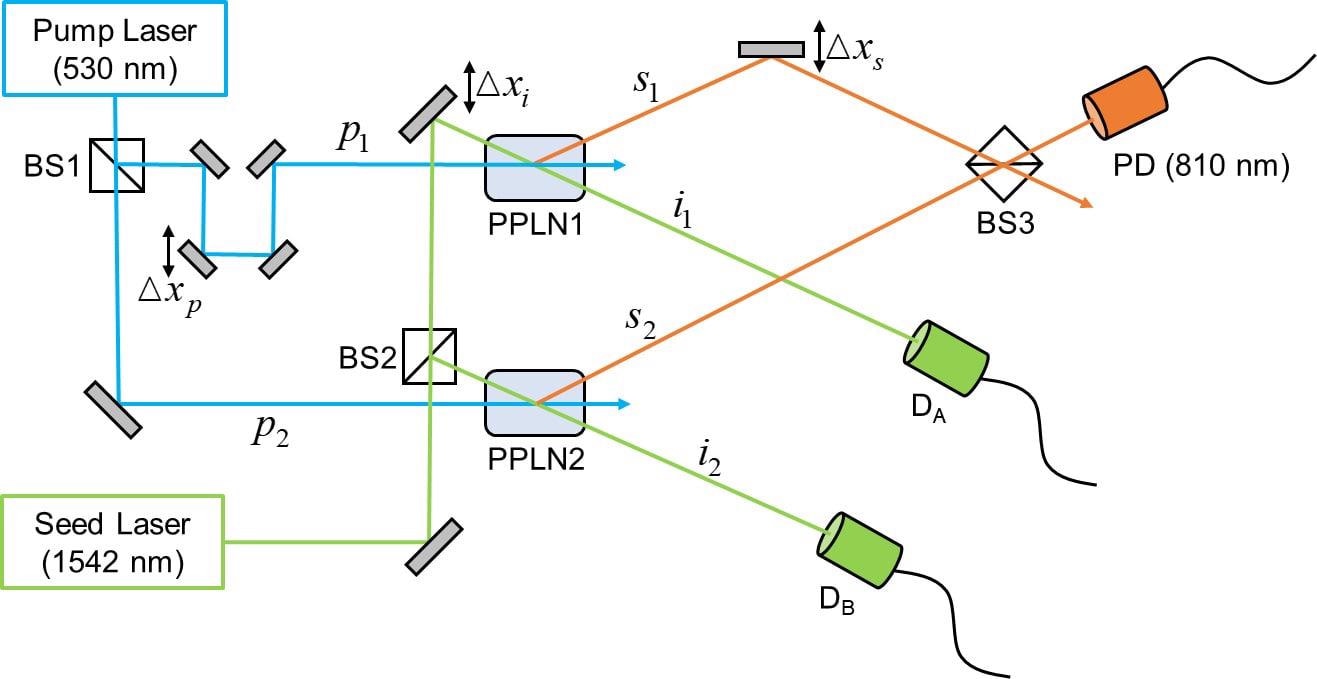Reviewed by Alex SmithAug 19 2021
The 21st century is an era of quantum science. Quantum mechanics originated in the early 20th century and supported the development of unique technologies such as quantum communication, quantum information, quantum metrology, quantum sensing and quantum imaging.
 Double-path single-photon interferometer with controllable source purity used in the ENBS model. Two SPDC crystals, PPLN1 and PPLN2, are pumped and seeded simultaneously by the same pump and seed coherent lasers, respectively, resulting in the emission of two signal photons s1 or s2 for quantum interference detection at PD. Then, conjugate idler photons i1 and i2 provide the which-path (or which-source) information, where the controllable source purity is determined by the overlap between the SPACS of one of the idler modes and the unchanged coherent state of another idler mode. Two idler fields can be detected independently by detectors DA and DB. Image Credit: Institute of Basic Science.
Double-path single-photon interferometer with controllable source purity used in the ENBS model. Two SPDC crystals, PPLN1 and PPLN2, are pumped and seeded simultaneously by the same pump and seed coherent lasers, respectively, resulting in the emission of two signal photons s1 or s2 for quantum interference detection at PD. Then, conjugate idler photons i1 and i2 provide the which-path (or which-source) information, where the controllable source purity is determined by the overlap between the SPACS of one of the idler modes and the unchanged coherent state of another idler mode. Two idler fields can be detected independently by detectors DA and DB. Image Credit: Institute of Basic Science.
Yet, quantum science still holds many unresolved and even inapprehensible problems that could not be understood, for example, wave-particle duality and complementarity, wave function collapse after quantum measurement, wave function entanglement of the composite wave function, superposition of wave functions, etc.
For a quantitative assessment of the basic principle of wave-particle duality and complementarity, a quantum composite system capable of being controlled by experimental parameters is required. Until now, there have been many theoretical proposals after Neils Bohr introduced the concept of “complementarity” in 1928. However, only some ideas have been assessed experimentally, where interference patterns were detected with reduced visibility.
Therefore, the concept of complementarity and wave-particle duality is difficult to explain and has not been completely confirmed experimentally.
To resolve this problem, researchers from the Institute of Basic Science (IBS, South Korea) built a double-path interferometer comprising two parametric down-conversion crystals, which are seeded by coherent idler fields. The device produces coherent signal photons (quantons) that are employed for quantum interference measurement.
The quantons further shift down in two separate paths before reaching the detector. The conjugate idler fields are utilized for yielding path information with controllable fidelity. This turns useful for quantitatively explaining the complementarity.
In the actual experiment, the source of quantons is not pure because of its entanglement with the remaining degrees of freedom. Yet, the purity of the quanton source is strictly bounded by the entanglement between the produced quantons and all the other remaining degrees of freedom through the relation μs = √(1 − E2). This relation was experimentally verified by the researchers.
The wave-particle duality and the quantitative complementarity P2 + V2 = μs2 (where P is a priori predictability and V is visibility) were studied and assessed using the entangled nonlinear bi-photon source (ENBS) system. Here, the quantons’ superposition states are quantum mechanically entangled with conjugate idler states, in a mode in which they can be controlled.
As per the explanation, the a priori predictability, visibility, entanglement (thus, source purity, and fidelity in the ENBS model) strongly relies on the seed beam photon numbers. This refers to the potential benefits of this method for making distant entangled photon states.
According to Richard Feynman, solving the problems of quantum mechanics lies in the understanding of the double-slit experiment. It is expected that the explanation based on the double-path interferometry experiments using ENBS will hold basic implications for gaining better insights into the principle of the complementarity and the wave-particle duality relation quantitatively.
Journal Reference:
Yoon, T H & Cho, M (2021) Quantitative complementarity of wave-particle duality. Science Advances. doi.org/10.1126/sciadv.abi9268.